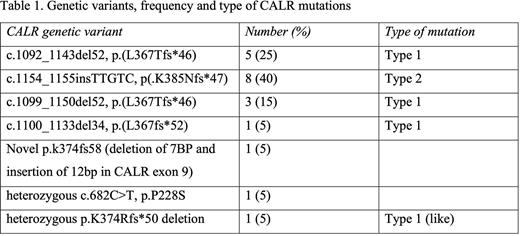Abstract
Introduction: Calreticulin (CALR) mutations comprise of a significant proportion of essential thrombocythemia (ET) patients. The frequency, types and clinical characteristics of ET patients with CALR mutations have not been widely studied. Moreover, ET patients with calreticulin (CALR) mutations are reported to have different characteristics and complications as compared to ET patients with other mutations.
Methods: We studied clinical characteristics and type of CALR mutations in ET patients diagnosed and managed at our center. Data were collected retrospectively from electronic health records and patients' files. We collected information on age, gender, presentation symptoms, history and development of vascular complications during follow up, risk category, blood counts at diagnosis, type of CALR mutation, therapy received, and any association of mutations with clinical and laboratory parameters.
Results: Twenty patients were diagnosed with ET harboring CALR mutations with a median age of 51 years (range 25-66); 14 (70%) were males. The diagnosis was made in most patients because of an incidental finding of high platelet count and only 3 (15%) had symptoms at diagnosis. One patient presented with limb ischemia at diagnosis while 3 patients had prior history of arterial vascular events. Majority of the patients were in the low-risk category (65%), while 5 (25%) patients had high-risk disease at diagnosis. Seventeen (85%) patients were treated with aspirin, 15 (75%) with hydroxyurea, and 3 with anagrelide. Median platelet count at diagnosis of ET was 960 x 109 (range 463-1584; reference 150-400). Eight (40%) patients had platelet counts above 960 x 109 at presentation. Table 1 shows the genetic variants, frequency and the type of CALR mutations. Two patients had mutations of uncertain significance in the CALR gene. After a median follow up of 48 months (range 2-204), only one patient developed thrombosis (pulmonary embolism); this patient also had arterial thrombosis previously. One patient with type 2 mutation progressed to myelofibrosis (MF) and remains alive on ruxolitinib and regular blood transfusions after 84 months of follow up post MF diagnosis. One 56-year-old male patient underwent surgery for coronary artery disease and severe aortic stenosis and died of hemothorax and multiple complication. Vascular events in 3 of the 4 patients occurred in those with type-2 mutations.
Conclusions: Majority of ET patients harboring CALR mutations were males and presented without symptoms with incidental diagnosis, and had low risk disease. Type 1 and 2 mutations occurred with almost equal frequency. Vascular complications were infrequent after diagnosis and only one patient developed thrombosis during follow up. These finding are consistent with other studies of ET with CALR mutations.
Disclosures
No relevant conflicts of interest to declare.
Author notes
Asterisk with author names denotes non-ASH members.


This feature is available to Subscribers Only
Sign In or Create an Account Close Modal